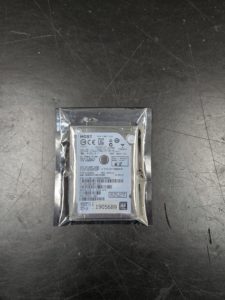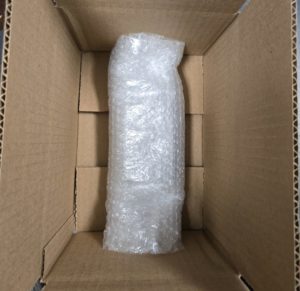Follow these guidelines to ensure your hard drive or storage device arrives safely at our lab.
1. Remove your device from your computer.

A hard drive in an anti-static bag.
When handling exposed circuit boards or removing a hard drive, we recommend wearing a grounding
strap. If a strap isn’t available, ground yourself by touching a bare metal object before handling the device. You can also have a professional handle the removal.
Make sure your computer is unplugged (not just powered off) before removing hard drives, solid-state drives (SSDs), and other internal media.
Some laptop manufacturers make the process fairly difficult for consumers, and in some cases, storage media is not removable (some Macs, for example, have the SSD embedded on the main board). If you cannot remove the drive, you can send the entire laptop.
2. Place your device in an anti-static bag.
For hard drives and other devices with an exposed circuit board, place the item in an anti-static bag. If you don’t have one, carefully wrap the device in aluminum foil.
3. Cushion your device with proper packing materials.

A hard drive packed in bubble wrap. Use about two inches (three layers) at minimum.
Use at least 2 inches of packing material (preferably foam or bubble wrap) on all sides of the device. Don’t use packing peanuts for heavier items; they tend to break up during transit and offer less protection.
Tape the packing material on all sides. You don’t need excessive tape, but ensure the device is securely held within its protective layers and won’t shift or come out during shipping.
A good rule of thumb: If you shake the box and hear or feel the drive moving, it’s not secure enough.

Hard drive packed into a cardboard box. The drive is firmly pressed against the sides of the box and won’t be able to move during transit.
4. Use a cardboard shipping box.
Always use a sturdy cardboard box that allows for sufficient packing material around the device.
Never use packing envelopes, including padded envelopes, for any type of media (including flash drives). Envelopes don’t provide sufficient protection and can lead to physical damage. Items may also fall out of torn envelopes during shipping.
5. Apply your shipping label.
After your ticket was opened, you should have received a shipping label; you can print this and tape it to your package for free shipping (USA and Canada only).
If you do not use the free shipping label, choose a shipping company that provides a tracking number.
6. For larger systems (like RAID arrays), discuss shipping with your customer service representative.
In most cases, we don’t require controller cards or RAID enclosures. However, all drives must be properly labeled to maintain their position within the array. Failure to mark drives can significantly complicate the data recovery process.
Additionally, each drive in a system must be packaged properly with at least 3 layers of bubble wrap per drive. Cushion each drive separately.
What if I’m uncomfortable shipping my hard drive, SSD, or other storage device?
If you’re uncomfortable shipping your device, you can bring it directly to one of our locations. All Datarecovery.com locations are full-service laboratories, not just mailing offices.
For any questions, contact our team. If you have any questions about packaging or shipping your device, please contact us at 1-800-237-4200 to speak with us.
Frequently Asked Questions (FAQs) About Shipping
How can static electricity damage a hard drive?
While rare, static electricity (electrostatic discharge or ESD) can potentially damage the sensitive electronic components on a hard drive’s printed circuit board (PCB).
Essentially, static creates a short circuit that can cause the device to behave unpredictably. Using anti-static bags or aluminum foil will eliminate this small risk.
Is shipping my drive safe?
Yes, especially when you choose a reputable shipping carrier. We recommend FedEx or UPS.
Once your device arrives at our facility, it immediately enters a secure environment. Our laboratories operate with strict security protocols.
Is my data secure with Datarecovery.com?
Absolutely. Data security is one of our core principles, and we have numerous controls in place to protect our clients’ privacy and security.
Our recovery laboratories operate on closed networks, ensuring that your data is never exposed to the public internet. Client information is only accessed when necessary to ensure the successful recovery of your data.
Our engineers don’t have general access to your files; they may open specific files identified by you as “important” to verify their completeness and integrity after recovery. All systems are continuously monitored, and non-disclosure agreements (NDAs) are available upon request for added peace of mind.
What happens if my package is lost or damaged during shipping?
If your package is lost or damaged, we will file a claim with the shipping carrier; if you do not use our shipping label, you would need to file a claim directly with the shipping carrier. The tracking number helps monitor its transit.
In our experience, lost packages or mishandled packages are extremely rare, especially when shipments are insured. We also accept couriered packages.
Do I need to send cables or accessories with my hard drive?
In most cases, no. For standard hard drive recoveries, we typically only need the hard drive itself. For larger systems like RAID arrays, we generally don’t require controller cards or other hardware, but always confirm with your customer service representative if you’re unsure about specific components for your device.
How long does shipping usually take?
Shipping times vary depending on the service you choose and your location. Standard ground shipping can take several business days, while expedited services can deliver within 1-2 days. Check with your chosen shipping carrier for estimated delivery times.
Can I use a signature required service for my shipment?
Yes, you can use a signature required service if you wish. This can add an extra layer of security, ensuring that someone at our facility signs for your package upon delivery.




